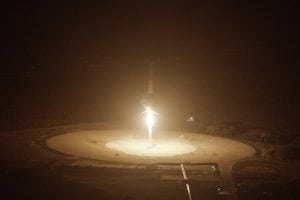SpaceX Returns to Flight, Lands Falcon 9 First Stage Booster

The first stage of SpaceX’s Falcon 9 landing at Cape Canaveral after orbiting 11 satellites for Orbcomm. Photo: SpaceX
[Via Satellite 12-22-2015] After a challenging year, SpaceX has returned to flight with an upgraded Falcon 9 rocket that successfully performed the company’s long-time goal of landing the first stage after delivering a payload to orbit. The Dec. 21 mission makes Orbcomm, whose 11 Second Generation (OG2) satellites reached their proper insertion orbit shortly after liftoff, a two-time inaugural customer for SpaceX, having now flown as the first commercial customer for the upgraded Falcon 9, and previously having signed up as the first commercial customer for the Falcon 1.
For both companies, the second and final OG2 launch is a momentous occasion. Orbcomm originally signed to launch its OG2 satellites on multiple Falcon 1s for $42.6 million. When SpaceX phased out this rocket, the contract switched to the Falcon 9. Though an OG2 prototype satellite mission ended prematurely due to a Falcon 9 anomaly in 2012, SpaceX delivered the rest of the fleet into correct orbits.
The latest launch completes Orbcomm’s new and improved constellation of 17 satellites, each of which supports 12 times the data access and up to double the transmission rate of an OG1 spacecraft.
For SpaceX, this mission fulfilled an obligation to one of the company’s most trusting customers, demonstrated a healthy return to flight after a high-profile launch failure, showcased the upgraded Falcon 9 and completed a critical step on the path toward reusability.
SpaceX previously demonstrated “soft landings” with the Falcon 9 first stage by hovering over ocean for a few seconds before falling in. Later the company attempted to land the booster on a sea-faring platform to no avail. The upgraded Falcon 9 rocket used yesterday for the Orbcomm mission took off from Cape Canaveral Air Force Station’s Space Launch Complex 40, and successfully landed its first stage booster approximately nine minutes later at Landing Zone 1, formerly known as Complex 13.
In an email to Via Satellite, SpaceX President and COO Gwynne Shotwell said the booster will undergo studies that will feed into future reusability demonstrations.
“We will test it thoroughly but will hold onto this one. I envision test flights for the next one we recover,” she said.
The OG2 mission is SpaceX’s first since June 28, when a Falcon 9 delivering cargo to the International Space Station (ISS) through NASA’s Commercial Resupply Services (CRS) contract exploded roughly two minutes into flight. Almost a month later, SpaceX identified a weak strut in the second stage of the rocket as the most probable cause of the mishap, which the company vowed to replace with a more durable version. Originally SpaceX hoped to return to flight by September, but this was pushed back to December.
Now having overcome this setback, SpaceX is set to resume more missions with the Falcon 9 in January 2016. The Jason 3 weather satellite, created through a partnership between NASA, NOAA, EUMETSAT and the French space agency CNES, is slated to launch Jan. 17. SES 9, an electrical propulsion satellite, arrived at Cape Canaveral Dec. 10 for a mid-January launch. SpaceX also has another CRS mission coming up for NASA.
The potency of SpaceX’s Falcon 9 landing would have been stronger were it not for Blue Origin, which successfully landed its New Shepard space vehicle after cresting the precipice of space in late November. New Shepard reached 100.5 kilometers, just half a kilometer above the Karman Line, which is widely recognized as the boundary for space. Jeff Bezos, founder of Blue Origin tweeted congrats to SpaceX Dec. 21, adding: “welcome to the club!”
Marco Caceres, senior analyst and director of space studies at Teal Group, told Via Satellite that it was no surprise SpaceX would continue nonplussed by Blue Origin’s accomplishment.
“It’s something that everybody anticipated, and it was only a question of time. Nobody believed SpaceX was going to give up on this technology, particularly after Blue Origin’s New Shepard,” he told Via Satellite, adding that the only partial surprise was SpaceX’s eagerness to demonstrate reusability on its first return mission. “A traditional company probably would have tried to launch one, two or three missions to regain credibility. But SpaceX isn’t a traditional company, so it doesn’t surprise me completely that SpaceX would move to aggressively test reusability on the first flight.”
SpaceX CEO and Lead Designer Elon Musk congratulated Bezos through Twitter following the New Shepard mission, but added that it was important to differentiate between “space” and “orbit.”
“Getting to space needs ~Mach 3, but [Geostationary Transfer Orbit] GTO orbit requires ~Mach 30. The energy needed is the square, i.e. nine units for space and 900 for orbit,” Musk tweeted on Nov. 24.
Details aside, the overarching theme is that launch providers new and established are all considering and/or working toward reusability in their own way as a method of reducing the cost of launch. United Launch Alliance (ULA), has reusable aspects of its next generation Vulcan rocket, Airbus Defence and Space is looking to save as much as 80 percent of the total launch vehicle value through its Advanced Expendable Launcher with Innovative engine Economy (Adeline) concept, which could be featured on the Ariane 6, and International Launch Services (ILS) owner Khrunichev is fitting the Angara family with RD-191 engines that can be reused up to five times. Attitudes toward reusable launch systems have shifted, and though technically SpaceX was not the first to retrieve a rocket intact from space, the company is still one of reusability’s most prominent flag bearers.
“SpaceX again is on the front pages, and they are now setting the pace for the future, not Blue Origin and Jeff Bezos,” added Caceres.